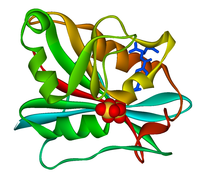
Photo from wikipedia
The maturation of HIV-1 capsid protein (CA) into a cone-shaped lattice encasing the condensed RNA genome is critical for viral infectivity. During HIV-1 maturation, CA can self-assemble into a wide… Click to show full abstract
The maturation of HIV-1 capsid protein (CA) into a cone-shaped lattice encasing the condensed RNA genome is critical for viral infectivity. During HIV-1 maturation, CA can self-assemble into a wide range of capsid morphologies made of ~175-250 hexamers and 12 pentamers. Most recently, the cellular polyanion inositol hexakisphosphate (IP6) has been demonstrated to facilitate conical capsid formation by coordinating a ring of arginine residues within the central cavity of capsid hexamers and pentamers. However, the precise kinetic interplay of events during IP6 and CA co-assembly is unclear. In this work, we use Coarse-grained Molecular Dynamics (CGMD) simulations to elucidate the underlying molecular mechanism of capsid formation, including the crucial role played by IP6. We show that IP6, in relatively small quantities at first, promotes curvature generation by trapping pentameric defects in the growing lattice and shifts assembly behavior towards kinetically favored outcomes. Our analysis also suggests that IP6 can stabilize metastable capsid intermediates and can induce structural pleomorphism in mature capsids. Teaser Computer simulations reveal that IP6 promotes fullerene-like capsid formation by stabilizing high curvature regions of the capsid.
Journal Title: Science Advances
Year Published: 2022
Link to full text (if available)
Share on Social Media: Sign Up to like & get
recommendations!